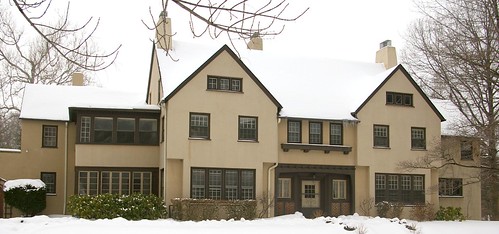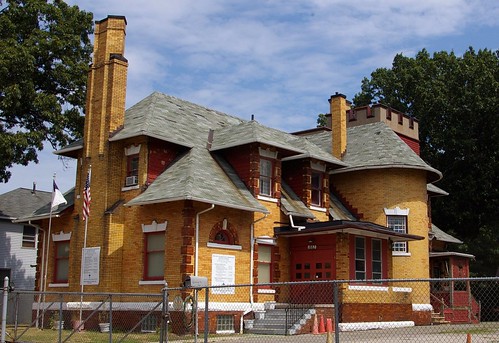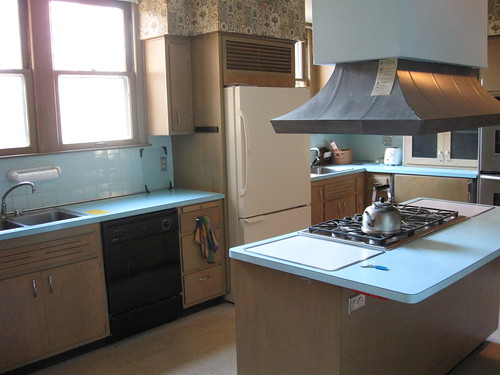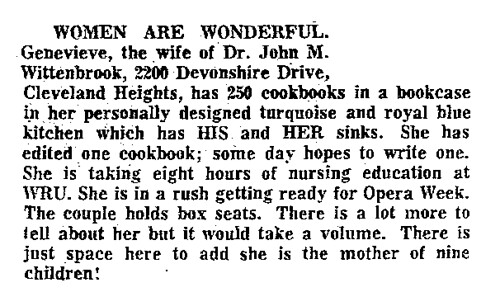
On Tuesday, I reported that this house, the James H. Foster residence, was slated for demolition. This 8,000+ square foot structure, at 2200 Devonshire Drive, Cleveland Heights, Ohio, is a contributing structure in the Ambler Heights Historic District. It is the oldest extant house designed by Walker and Weeks, the Cleveland Architectural firm responsible for Public Auditorium, the Federal Reserve Bank of Cleveland, Severance Hall, the Lorain-Carnegie Bridge, and the main building of Cleveland Public Library.
On Tuesday, I dealt with the house and gardens. Today, I'll address the history of the people who lived here.
James H. Foster purchased the land this house is sited on in August, 1911, from Elizabeth S. Caswell and Martha B. Ambler. (Cuyahoga County Recorder, AFN: 191108160057 and 191108160058) He hired Walker and Weeks to design the house, which was completed in 1911 or 1912.
Samuel Orth, in his History of Cleveland, Ohio (pages 637 and 638) describes Mr. Foster:
James H. Foster, whose relation to the public interests of Cleveland is that of vice president and general manager of the Hydraulic Pressed Steel Company, is contributing through his activity in this field to the business enterprise that has led to the growth of the city and given it rank with the ten largest cities of the Union. Of New England birth and ancestry, he is a direct descendant of Thomas Foster, who was one of the early settlers of the Hartford colony of Connecticut, having come to America from England in 1660. His grandfather, Hiram Foster, was a prominent Connecticut manufacturer. His father, Samuel H. Foster, was a native of Meriden, Connecticut, and the senior member of the well known hardware manufacturing firm of Foster, Merriam & Company. He served during the Civil war on the staff of General Phil Sheridan and military and commercial duties were alike carefully guarded in his hands. His death occurred in 1889, when he had reached the age of fifty-four years. His wife, who bore the maiden name of Mary Stanley, was a daughter of Augustus and Elvira (Conklin) Stanley. The Stanleys are one of the old New England families and were founders of the Stanley Rule and Level Company of New Britain, Connecticut.By 1918, he was president of the Hydraulic Pressed Steel Company of Cleveland, described in A History of Cleveland and its Environs (page 371) as
James H. Foster was born in Meriden, Connecticut, April 10, 1879. Pursuing a course in St. Paul's school at Concord, New Hampshire, he thus prepared for collegiate work, which he received in Yale University and Williams College, being graduated from the latter with the degree of Bachelor of Arts as a member of the class of 1900. Thus equipped by liberal education for a business career, he turned his attention to real-estate operations in Pittsburg, Pennsylvania, where he continued for one year. During the succeeding three years he was connected with the American Tubular Wheel Company and in 1904 came to Cleveland, entering into active association with the firm of Parish & Bingham in the capacity of assistant general manager. He thus served until August, 1906, when he organized the Hydraulic Pressed Steel Company, with a capital of one hundred and fifty thousand dollars, and was elected vice president and general manager. From a modest beginning the business has advanced by leaps and bounds until it is the largest institution of its kind in Cleveland, doing a business of one million dollars annually. The plant covers six acres and its capacity is being doubled yearly. Several of the most powerful presses ever constructed are in use in this plant, the largest striking a blow of eight thousand tons at the rate of eight strokes per minute. Their product finds ready market in every section of the United States and the export business is continually increasing. Mr. Foster has contributed in substantial measure to the development of this concern, having knowledge and business experience which have constituted a safe foundation on which to build the success of the enterprise. He is also a director of the Ohio Sherardizing Company and the vice president of the Citizens Taxicab Company.
On the 28th of September, 1907, occurred the marriage of Mr. Foster and Miss Edith A. Mcintosh, a daughter of George T. and Elizabeth (Ellis) Mcintosh, of Cleveland. Their only child is George Mcintosh Foster. Their home, at No. 1932 East Seventy-First street, is the abode of a warm-hearted and generous hospitality. Mr. and Mrs. Foster are members of the Emmanuel church and in church and charitable work Mrs. Foster takes active and helpful part. Mr. Foster belongs also to the East End Tennis Club and the Hermit Club, while his political endorsement is given the republican party. His leisure hours are devoted to golf, tennis, baseball and various outdoor athletic sports. Pleasure, however, is always the secondary consideration to business with him and his success in manufacturing circles is due to an unlimited capacity for hard work, splendid executive ability and the faculty of enlisting the support and cooperation of strong business men in his projects.
"An industry with a history of more than ten years of prosperous growth and now without question one of the leading concerns in contributing to Cleveland's greatness as a center of the iron and steel industry.
Mr. Foster learned the steel business through a rigorous apprenticeship. His first experience was in the Pittsburgh district, where he worked for the steel mills at any post of service which his superiors saw fit to assign him. He began there in 1900, fresh from a college career. He had been previously nurtured in the scholastic atmosphere of old New England. His birth occurred in Meriden, Connecticut. April 10, 1879, a son of Samuel H. and Mary (Stanley) Foster.
In 1885 the family moved to New Britain, Connecticut, where James H. Foster attended the public schools. He afterwards completed a preparatory course in St. Paul School at Concord, New Hampshire, and in 1896 attended Yale University, but a year later transferred to Williams College, from which he graduated in 1900.
After his three years of apprenticeship in the iron and steel district around Pittsburgh, Mr. Foster came to Cleveland and found a position with the Parish & Bingham Company in their sheet metal stamping works. In a short time he was manager of this plant and filled that position until 1906.
In that year he was instrumental in organizing and incorporating the Hydraulic Pressed Steel Company. The first officers of this organization were: A. W. Elleuberger, president; Mr. Foster vice president and general manager; and H. F. Pattee, secretary and treasurer. The plant was ready for operation in 1907. It then contained 20,000 square feet of floor space. The plants now include a steel plant of four open-hearth furnaces, rolling mills, sheet mills, etc., located at Canton, Ohio, and two fabricating plants in Cleveland. These plants occupy 133 acres of land, have an aggregate capital of over $12,000,000 and employ about 5.000 men. The present officers are: A. W. Elleuberger, chairman of the board; J. H. Foster, president; Ernest E. Bell, vice president and director of sales; R. R. Freer, vice president and comptroller; R. D. Mock, treasurer; H. F. Pattee, secretary.
Mr. Foster is a member of the Union Club, Country Club, Mayfield Club, Roadside Country Club and Hermit Club. Politically he does his voting according to the dictates of an independent judgment. In Cleveland, September 28, 1907, he married Miss Edith Mcintosh. They have four children: George, aged nine; Mary Stanley, aged seven; James H., Jr., aged five; and Elizabeth Mcintosh, aged three. George is a pupil in the Hawkins School for Boys, while Mary Stanley attends the Laurel School for Girls.
The Fosters lived in the house until 1936, when it was transferred (possibly the result of foreclosure) to the Guardian Trust Co. (Cuyahoga County Recorder, AFN: 193608180078) The Guardian Trust Co., in 1945, sold the house to Emmie E. and Harvey B. Brackenridge. (Cuyahoga County Recorder, AFN: 194511210122)

Prior to their move here, the Brackenridge family lived at 1883 East 84th Street. (Plain Dealer, 4 June 1942, page 17) They, in turn, sold the house in 1951 to Dr. John M. Wittenbrook and Genevieve Wittenbrook. (Cuyahoga County Recorder, AFN: 195101100109)

From left, Dr. and Mrs. John M. Wittenbrook and Mr. and Mrs. Robert M. Hornung. Plain Dealer Photos (Richard J. Misch and Robert J. Quinlan) From the Cleveland Plain Dealer, 24 April 1962, page 21.
Dr. John M. Wittenbrook, a psychiatrist and Genevieve Wittenbrook raised a large family in this house. (Cleveland Press 31 May 1972)

Photo courtesy of a Cleveland Area History reader.
Remeber this photo, which ran in part one of the story? The Cleveland Plain Dealer, 16 April 1964, page 19 provides an interesting bit of history on it.

Dr. Wittenbrook died in 1972. (Cleveland Necrology File) In 1973, Genevieve Wittenbrook sold the house to George H. and Karole V. Baird. (Cuyahoga County Recorder, AFN: 00621483)
George H. Baird was the former research head of Shaker Heights schools and Founder of Educational Research Council of Greater Cleveland. (Time, 30 May 1960.)
George Baird died in 1997. (Plain Dealer 26 March 1997, page B8)
Kirk S. Ramsey, trustee of the Karole V. Baird Trust, sold the house to Steven E. Nissen and Linda R. Butler in December of 2010. (Cuyahoga County Recorder, AFN: 201012220312) Dr. Nissen is Chairman of the Robert and Suzanne Tomsich Department of Cardiovascular Medicine at the Cleveland Clinic. He was named one of Time magazine's 100 Most Influential People. (Time, 14 May 2007)
The relatively long tenure of the residents of this house is part of what has kept it in such good condition. All the evidence that I've seen suggests that this house is (or was, prior recent work) quite habitable as-is. Even the kitchen, which some seem to grimace at, is a good, solid, workable space. Would it look better with matching appliances and without the wallpaper? Yes. But these are minor things, matters of taste.
If you do have evidence to the contrary, please email me, that I may share it here.
The question being raised here is not just whether this landmark deserves to stay, but what what are the rights of the community when someone tries to substaintially alter the neighborhood.




Steven Nissen's wife, photographer Linda Butler is no slouch either. Winner of the 1999 Cleveland Arts Prize for Visual Arts, she is the author of several books, one of which is "Yangtze Remembered: The River Beneath the Lake".
ReplyDeleteCleveland Magazine lists Nissen as one of its Most Interesting People 2011 and quotes him saying "I always wanted to make a difference, and I think I have". Let us hope that one of the differences he makes is not the destruction of this block in Cleveland Heights.
Indeed. Thank you for correcting that most embarrassing oversight on my part.
ReplyDeleteShame on Cleveland Heights leaders in government, business and the non-proft arena for not having any preservation structure in place to prevent history like the Foster House from simply being demolished.
ReplyDeleteLaura Peskin